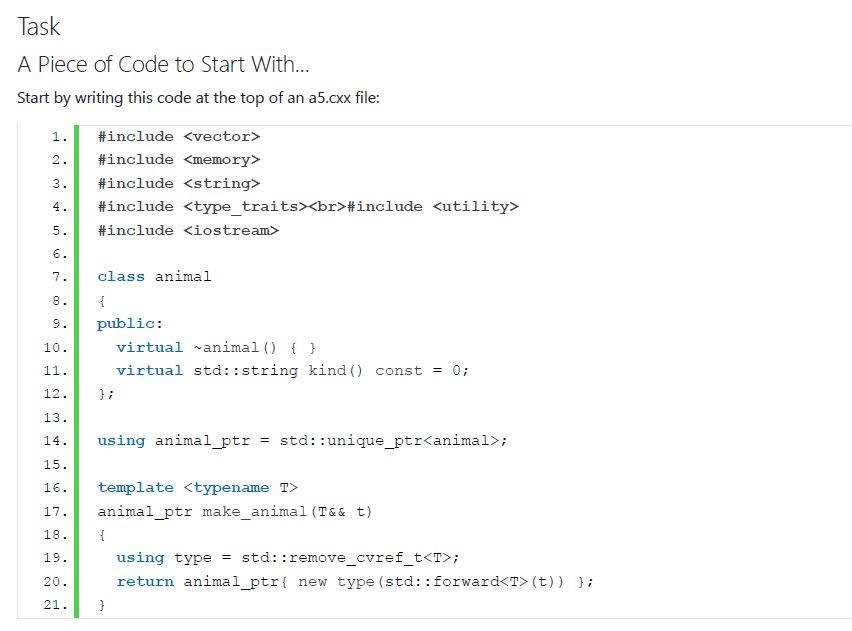Help needed asap. Please show me how to implement the following classes numbered in red with the code that is provided in the screenshot below. Please help! I will give the best rating for help.





Task A Piece of Code to Start With... Start by writing this code at the top of an a5.cxx file: 1. 2. 3. #include
#include #include #include #include 5. 6. 7. 8. 9. class animal { public: virtual -animal() { } virtual std::string kind() const = 0; }; 10. 11. 12. 13. 14. using animal_ptr = std:: unique_ptr; 15. 16. 17. 18. template animal_ptr make_animal (T&& t) { using type std::remove_cvref_t; return animal_ptr{ new type (std:: forward(t)) }; } 19. 20. 21. Writing the Cat Class Define a class called cat as follows: . the class needs to inherit publicly and virtually from animal, the class has a single public member kind() that overrides the kind() (abstract) function in animal and returns "Felis catus"s. Writing the Dog Class Define a class called dog as follows: . the class needs to inherit publicly and virtually from animal, the class has a single private data member of type std::string (choose a variable name to use), the class has a deleted default constructor, the class has a defaulted copy constructor, the class has a defaulted copy assignment operator, the class has a constructor accepting a std::string const& parameter which is the name of the dog being constructed, (This constructor must also set the value of the private data member std::string using direct initialization BEFORE the opening_{' of the constructor.) the class has a kind() member function that overrides animal::kind and returns "Canis lupus familiaris's, and, the class has a name() member function that returns the type std::string const&, i.e., it returns the private data member defined earlier. (This function must also be const-qualified). . Writing the dogcat Class Unfortunately you have to deal with hybrid organisms too --so you need to define a class called dogcat as follows: . the class (multiply) inherits both publicly and virtually from both dog and from cat, the class has a default constructor that invokes the parent dog constructor with the name "hybrid" and the default cat constructor, the class has a constructor that has two parameters (dog const& d and cat const& c) and invokes the corresponding parameter class' copy constructor passing in d or c respectively, the class has a defaulted copy constructor, the class has a defaulted copy assignment operator, and, the class has a kind() member function that overrides animal::kind and returns the result of calling dog's kind(), + (i.e., string append), the string" +", + (i.e., string append), and calling cat's kind(). Tips: A dogcat's kind() function returns a string that is a concatenation of its dog's kind()," + ", and its cat's kind(). A dogcat's name is always "hybrid" if default constructed. Writing operator+(dog const& d, cat const& c) To make it easier to create dogcat hyrbids, write an operator + () overload as follows: the function has two parameters: dog const&d and cat const&c, the function return type is dogcat, and, the return expression must create a dogcat object from d and c passing in d and c to a dogcat constructor. . . Writing main() The above classes will now be used in main() as follows: . declare a std::vector variable called v, declare a variable, d, of type dog passing in the name "Fido", default construct a variable of type cat called c, call v.push_back() with the result of calling make_animal(d), call v.emplace back(). with the result of dynamically allocating a cat value using operator new, call v.push_back() with the result of calling make_animal(d+c). The variable v is effectively an array of pointers to animal objects. Its pointers are, however, stored in a "smart pointer" type called std:unique ptr which will automatically call operator delete when it is destroyed. Another useful smart pointer type is called std::shared ptr which allows multiple std::shared_ptr variables to refer to the same object. Like std::unique_ptr, std::shared_ptr also ensures that the dynamically allocated memory associated with its contents is also destroyed. This is why this program does not directly call operator delete to free allocated memory. So the fact that C++ does not have garbage collection is not really an issue: one can make use of C++ destructors in types to "clean up" resources. When this is done, this coding pattern is called RAIL(Resource Acquisition Is Initialization). With the above, let's process polymorphically the animals in the vector object as follows: . open a (multi-line) range-for loop over all elements e of v (each element type should be auto const&, or if you prefer, animal_ptr const&) and inside the for loop: output to std::cout the output of e's kind() member function, create a variable called p of type dog* and assign the result of dynamically casting the result of calling e.get() to dog*, if p is not nullptr then output to std::cout the string", name = " (without quotes), followed by the result of calling the name() function pointed to by p, and, output the newline character to std::cout












